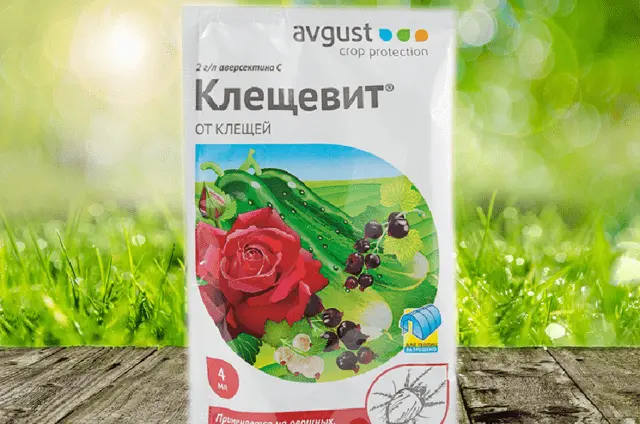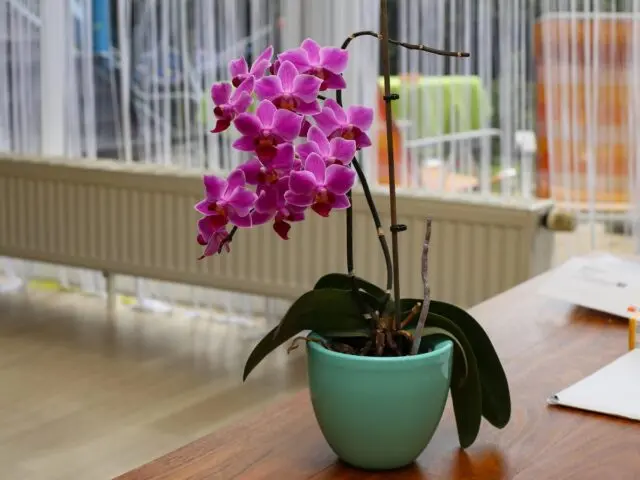Contents
Instructions for use Kleshchevit contains a description of the composition, form of release, dosage and other important characteristics. The tool is used to treat fruit and berry, vegetable, ornamental, flower plants from various types of mites and many pests, such as aphids, weevils, scale insects, scoops. In most cases, the standard concentration is 2 ml of product per 1 liter of water for spraying 10 m2.
appointment
Kleshchevit is a biological preparation for combating the following types of ticks:
- gossamer;
- ixodid;
- kidney;
- red fruit;
- Schlechtendal;
- mealybug.
Kleschevit is often called an insecticide, although this is not entirely correct. It is an acaricide, since it is used specifically against ticks (biologically they do not belong to the class of insects). Although it can also be used to protect against common insects, for example:
- aphid;
- codling moth apple;
- scoop;
- cabbage moth;
- leaflet;
- weevil;
- shield;
- thrips flower;
- white cabbage and turnip;
- colorado potato beetle.
The drug Kleshchevit is used to protect various plants:
- cucumbers;
- pepper;
- eggplants;
- tomatoes;
- Apple tree;
- currants of different types;
- flowers in greenhouses and outdoors.
Kleshchevit is also used to treat indoor flowers from spider mites. At the same time, other means are used to control insects – insecticides (Biotlin, Fitoverm, Decis).
Composition and form of release of the drug Kleschevit
The active substance of the drug Kleshchevit is aversectin C. This is an organic compound belonging to the class of avermectins. It is of natural origin, as it is synthesized by special strains of bacteria. Therefore, Kleschevit refers to biological acaricides and is safe for humans, beneficial insects (bees) and plants.
The drug is produced in the form of a concentrated liquid in ampoules (4 ml each) or in vials (10 ml each) with an active ingredient concentration of 0,2%. There is also another variety – Kleshchevit Super, which includes technical cypermethrin (25% dosage). It is produced in 100 ml bottles or in the form of convenient 100 ml spray bottles.

The drug destroys both ticks and other harmful insects
Principle of operation
Kleshchevit has contact and intestinal action. The substance enters the pest’s body by direct contact with the integument of the body, as well as by eating the juice of the treated plant. Aversectin C acts on the nervous system of the tick and quickly leads to paralysis.
In the first 8-10 hours, pests lose their activity, stop eating plant tissues. Complete death is noted after 2-3 days. The protective effect lasts up to 5-7 days. At the same time, harvesting can be started in 2-3 days. Treatment with Kleshchevit is carried out up to three times per season – at the beginning of the growing season, during the formation of buds and, if necessary, at the fruiting stage. In this case, the interval between treatments should be at least seven days.
Therefore, processing is best done in warm weather. In extreme cases, you can work at a minimum temperature of +15 °C.
Advantages and disadvantages
A review of the drug Kleshchevit and reviews of gardeners shows that it has quite a few significant advantages.

The chemical agent is valued for its speed, the death of insects occurs within a few hours
Pros:
- efficiency (total death of ticks after 2-3 days);
- wide range of influence;
- slightly toxic to humans, warm-blooded animals, bees;
- economic benefit (low consumption);
- short waiting times;
- can be used at the fruiting stage;
- compatible with many drugs.
Cons:
- the period of protective action is not more than a week;
- the solution does not penetrate the tissues, so the pests can return again and feed on the juices;
- resistance in spider mites is formed after 3-4 treatments.
Instructions for use of the insecticide Kleschevit
Preparing the solution is quite simple. The instruction is as follows:
- Wear gloves.
- Measure the desired volume with a syringe or other method.
- Dissolve first in a small amount of water at room temperature.
- To stir thoroughly.
- Bring to a total volume and shake again.
- Pour into a spray bottle and start processing. It is better to spray late in the evening in dry and calm weather.

It is more convenient to treat large areas with a sprayer
cucumbers
Cucumbers in greenhouses often suffer from spider mites. For their destruction, a solution of Kleshchevit is used in a ratio of 10 ml per 1 liter. This amount is enough to spray several beds with a total area of 10 m2. Up to three sprays per season are carried out with an interval of at least 20 days. You can start harvesting in 2-3 days.
Tomatoes
The drug Kleshchevit is used to treat tomato seedlings. This can be done a few days before transplanting to the greenhouse, to the garden, or immediately after. Repeated spraying is carried out if necessary. The concentration of the solution is the same – 10 ml per 1 liter for treating an area of 10 square meters. Up to three treatments per season are allowed with an interval of 20 days. You can harvest in 2-3 days.
Apple tree
The drug Kleshchevit is used to protect apple trees and other trees from red spider mites, ixodid mites. The latter do not pose a danger to the plant, but can spread infections that are deadly to humans, including encephalitis and borreliosis. Spraying is also carried out to protect against Schlechtendal mites.
To obtain a solution, they are guided by a dosage of 1,5 ml per 1 liter or 15 ml per 10 liters (standard bucket). Spraying is done in late spring and summer up to three times per season with an interval of 2-3 weeks. At the same time, from 2 to 5 liters are spent on one tree. The consumption rate depends on the age, size and density of the crown.
Kleschevit for currants
The drug Kleshchevit is used against spider mites and kidney mites on currants (black, red, white). To do this, prepare a solution based on a dosage of 2 ml per 1 liter. This volume is enough to spray one bush. Up to three treatments are carried out per season. The waiting period before picking berries is two days.
Kleschevit for indoor flowers
Kleschevit is used for orchids and many other flowers, as they too can suffer from spider mites and some insects. To do this, prepare a solution of standard concentration – 2 ml per 1 liter. This amount is enough conditionally for 10 m2 landings, i.e. for all indoor plants. A similar norm is observed when processing flowers growing in a greenhouse.

The tool is used to process orchids and other indoor flowers.
Ornamental and flower crops
The drug Kleshchevit is also used for spraying flowering crops growing in open ground. In this case, a solution of 2 ml per 1 liter is prepared, the indicated volume is used to process 10 square meters of plantings. The number of treatments – up to three per season with an interval of 7-10 days.
Coniferous
Kleshchevit can also be used to process conifers. This is especially true for city parks, squares, where ticks are often activated in spring, which are carriers of dangerous diseases. The standard concentration of 2 ml per 1 liter or 20 ml per 10 liters is taken as a basis. 2-5 liters are spent on one tree, depending on the size. Processing is carried out up to three times per season with an interval of 10 days. It is especially important to do this in April and May.
Compatibility with other means
Kleschevit is quite well compatible with drugs belonging to the class of organic phosphates (Aktellik, Fufanon) or pyrethroids (for example, Talstar). However, it cannot be used in combination with insecticides of the same class (avermectins), for example, with the well-known Vertimek.
Kleschevit combines well with most fungicides, with the exception of those that give an alkaline reaction (pH greater than 7,0). Therefore, before tank-mixing, it is recommended to carry out a chemical test using indicator paper or a pH meter. Also, the tool can be used in combination with growth stimulants – “Epin”, “Heteroauxin” and many others.
Therefore, the drug Kleshchevit should be alternated with other acaricides and insecticides.
Safety Precautions
The drug is slightly toxic to humans and bees (in both cases, hazard class 3). Therefore, during processing, it is recommended to observe the minimum safety rules:
- Use gloves.
- During spraying, do not talk, do not eat or drink.
- Exclude access for children.
- Avoid contact with eyes, stomach.
- If the solution is on the body, wash off with soap and water.
- In case of contact with eyes, rinse thoroughly under running water.
- In case of mistaken ingestion, chew several tablets of activated charcoal and drink plenty of water. In extreme cases, seek medical attention.

It is necessary to work with a chemical agent in a mask
The prepared solution is not stored for a long time, so it is prepared in such a volume that it can actually be used up at a time. Vials or ampoules are stored in a wide temperature range – from -20 to +30 degrees in dark places (without direct sunlight). Children are excluded from access.
Analogues of the drug Kleschevit
The analogues of the drug Kleshchevit on the active substance include the following agents:
- “Inta-Vir”;
- “Carbocin”;
- “Lightning Extra”;
- “Fitoverm”;
- “Shar pei”;
- “Alatar”.
Each of them has its own advantages and disadvantages.
Conclusion
Instructions for using Kleshchevit are quite simple. The drug is relatively safe, the concentrate dissolves well in water. Up to 2-3 sprays are carried out per season. At the same time, it is important to alternate acaricide with other means, because otherwise the pests will quickly develop immunity.









